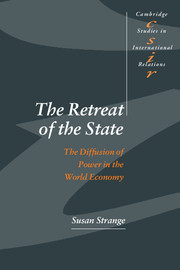Book contents
- Frontmatter
- Contents
- Preface
- Part I Theoretical foundations
- Part II Some empirical evidence
- 6 Authority beyond the state
- 7 Telecoms: the control of communication
- 8 Organised crime: the mafias
- 9 Insurance business: the risk managers
- 10 The Big Six accountants
- 11 Cartels and private protectionism
- 12 International organisations: the econocrats
- Part III Conclusions
- References
- Index
- CAMBRIDGE STUDIES IN INTERNATIONAL RELATIONS
8 - Organised crime: the mafias
from Part II - Some empirical evidence
Published online by Cambridge University Press: 07 October 2009
- Frontmatter
- Contents
- Preface
- Part I Theoretical foundations
- Part II Some empirical evidence
- 6 Authority beyond the state
- 7 Telecoms: the control of communication
- 8 Organised crime: the mafias
- 9 Insurance business: the risk managers
- 10 The Big Six accountants
- 11 Cartels and private protectionism
- 12 International organisations: the econocrats
- Part III Conclusions
- References
- Index
- CAMBRIDGE STUDIES IN INTERNATIONAL RELATIONS
Summary
Like transnational enterprises, organised criminal gangs – mafias, for short – have been around for a long time. Neither is a new phenomenon. Yet in both cases, what is new is their number; the expanding extent of their transnational operations; and the degree to which their authority in world society, and in world economy rivals and encroaches upon that of governments (Naylor, 1993: 13–51; Arlacchi, 1992a, b).
Cosa Nostra, which is probably the best-known, and the original exemplar of the term, ‘mafia’, also provides the model of organised counter-government. It engages in activities declared criminal and illegal by the government of the state, but at the same time imitates, in mirror fashion, many of the characteristics of formal state government.
For example, its authority – like that of a state – is exercised through an established power structure, by means of which obedience is rewarded and disobedience punished, occasionally by the use of violence and always by the threat of violence. In both state and mafia, the path to power may be achieved by force, quelling and discouraging opposition. Or it may be by peaceful persuasion exercised through some kind of electoral process. For instance, up to the 1960s, most of the Sicilian mafia groups elected the head of each cosa every year, and major decisions were taken collegially.
Both states and mafias own and operate economic enterprises, although for both the survival of the organisation takes precedence over profit maximisation.
- Type
- Chapter
- Information
- The Retreat of the StateThe Diffusion of Power in the World Economy, pp. 110 - 121Publisher: Cambridge University PressPrint publication year: 1996

